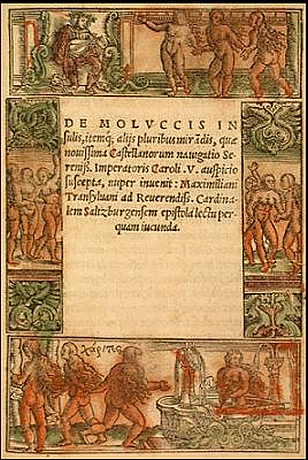As a layman and not some pedigreed historian nor sectarian televangelist, I’m doing this chronological review of a landmark historical event simply to understand why Mazaua got displaced by Limasawa as the site of the first Holy Mass in our shores.
I was determined not to touch on the geopolitical, dynastic, evangelical, nationalist, and personal motivations of the dramatis personae in this aspect of Philippine history. After all, this is beyond my competence as a layman and is best left to competent, totally scrupulous historians.
Before proceeding, though, I’d like to bring our chronological review back again to the year 1555, which I’m now convinced was a watershed in how the narrative about Magellan’s voyage was to evolve in the next 466 years until today.
Recall that it was in 1555 that Richard Eden’s English translation of a supposedly authentic chronicle of the Magellanic voyage to the Indies was published in London. That pirated French chronicle,
“Le voyage et nauigation,” first appeared in Paris sometime in 1525. The Venetian geographer-travel writer Giovanni Batistta Ramusio had been presumed to have first anonymously translated that anonymous French text into Italian but abridged it 11 years later and included it in his
“Navigationi et Viaggi” in 1550, which then became the basis for Eden’s English translation (
https://tinyurl.com/3ydbjvfn).
Left: Front cover of “Delle Navigationi et Viaggi,” Giovanni Battista Ramusio's translation into Italian of “Le voyage et nauigation,” a French version of Pigafetta's chronicles of the Magellanic voyage. Right: Front cover of Decades of the New World, Richard Eden's English translations of Peter Martyr's anthology of pioneer voyages in the Age of Expedition, including Pigafetta's chronicles of the Magellanic voyage.But something more remarkable happened in 1522 that would decisively shape the narrative of the Magellanic voyage. This was when Maximilianus Transylvanus, a courtier of Roman Emperor Charles V, indiscriminately appropriated Ramusio’s abridgment of his
“Navigationi et Viaggi” text for Magellan’s voyage for a sensational, rousing advocacy that was styled as a letter to Cardinal-Archbishop Matthäus Lang von Wellenburg of Salzburg.
With astonishing speed, Maximilianus had come up with that tract less than 45 days after the return to Spain of the Magellanic fleet’s lone surviving ship Victoria on September 8, 1522. Maximilianus then presented his Latin tract,
“De Moluccis Insulis,” with great aplomb to the cardinal-archbishop on October 23.
Maximilianus literally allowed Ramusio’s persona to take over his own self in that tract, using a narrative device that allowed Maximilianus to glowingly heap praises on himself and those who supported his advocacy of Magellan’s voyage and to disparage those who differed from his appraisal of the value of Pigafetta’s firsthand narrative.
Four extremely sensational assertions in Maximilianus’ introduction to
“De Moluccis Insulis”:
1. “The voyage made by the Spaniards round the world in the space of three years is one of the greatest and most marvellous things which have been heard of in our times...”
2. Peter Martyr was entrusted by the Roman Emperor Charles V to write the definitive history of the Magellanic voyage, but when Peter’s history book was to be printed in Rome, “it was lost in the miserable sacking of that city.”
3. Even if Peter Martyr’s history book got lost, “the memory of so marvellous an enterprise” was not entirely gone because a Venetian gentleman, Antonio Pigafetta, wrote “a very exact and full account of it,” one copy of which he presented to Emperor Charles V, and the other to the emperor’s aunt Margaret of Austria, Duchess of Savoy.
4. The Duchess commissioned one Jacomo Fabre to translate it into French, but “(t)his worthy person…made only a summary of it, leaving out what seemed fit to him; and this was printed, very incorrectly, in France, and has now come into our hands; and along with it a letter from one called Maximilianus of Transylvania…to the most Reverend Cardinal of Salzburg…”

Just these circuitous claims in that introduction, and not even touching yet on the fidelity of Ramusio’s narrative to Pigafetta’s account (
https://tinyurl.com/pf7h45du), certainly would raise eyebrows even today over what Transylvanus and Ramusio were up to in not being precise and straightforward in telling them.
(Next:
Getting our history right after 500 years - 5) April 22, 2021
This essay, 2,041st of the series, appeared in the column “English Plain and Simple” by Jose A. Carillo in the Campus Press section of the April 15, 2021 Internet edition of The Manila Times
,© 2021 by the Manila Times Publishing Corp. All rights reserved. Read this article online in
The Manila Times:
“Getting our history right after 500 years - 4”To listen to the audio version of this article, click the encircled double triangle logo in its online posting in
The Manila Times.
2.
Getting our Philippine history right after 500 years - Part 23.
Getting our Philippine history right after 500 years - Part 3 4.
Getting our Philippine history right after 500 years - Part 4 THIS POST
5.
Getting our Philippine history right after 500 years - Part 56.
Getting our Philippine history right after 500 years - Part 6 TO BE CONTINUED